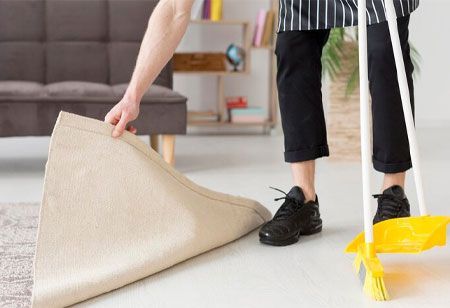
Does your living room rug seem a little lackluster?
With regular use, an unkempt rug not only dulls the look of your home but could also be detrimental to your health. Keeping it in pristine condition is crucial for home hygiene.
Rug Wash Specialist emphasizes that regular and proper cleaning can significantly reduce health risks, maintaining the longevity and aesthetics of your rug.
They urge homeowners to recognize the importance of frequent rug maintenance for fresher, healthier living spaces.
Ignoring your rug's cleanliness could lead to a buildup of dust mites, allergens, and bacteria which adversely affect air quality.
Regular professional cleaning ensures these problems are kept at bay whilst keeping your rug vibrant.
Professional deep cleansing of your rugs every 12-18 months is strongly recommended by carpet manufacturers and the Carpet and Rug Institute.
Everybody benefits from a routinely cleaned rug. From homeowners to workspaces, clean rugs contribute significantly to a healthful and pleasant environment.
High-traffic areas face the brunt of daily grime and dirt. Rugs in such locations stand strong as our first line of defense, constantly trapping dust particles.
Rugs gather pollutants over time. To extract these pollutants, deep cleaning methods are needed which may involve professional services or renting a carpet cleaner.
Deep cleaning is recommended every 12 to 18 months. In the meantime, rugs can be maintained through regular vacuuming and immediate cleaning of spills.
Manufacturer recommendations suggest deep rug cleaning every 12-18 months. Regular maintenance, however, requires more frequent attention.
Vacuuming your rugs twice a week with slow, repetitive strokes helps keep them clean.
Rugs require more than just visible cleaning; hidden dirt and allergens can also affect your home's hygiene.
Your diligence in maintaining blankets of comfort on your floor will provide a healthier environment for everyone at home.
Launching the journey towards clean carpets requires particular tools and materials. Gather them ahead of time to ensure an efficient deep cleaning session.
You will need to procure items such as a vacuum cleaner, carpet shampoo or cleaner, a carpet brush and a bucket filled with clean warm water.
The initial step before cleaning is preparing the area. Ensure a clear space by removing furniture and protecting remaining legs with aluminum foil or plastic.
Every corner, edge, and traffic-heavy zone of your rug needs detailed attention. Use specific vacuum attachments such as a crevice tool or upholstery brush.
Regularly empty your vacuum cleaner bag or canister to maintain peak performance. Before cleaning, scrutinize your rug for any stains or extremely soiled regions.
An effective spot-cleaning solution like equal parts water and white vinegar can tackle these tricky areas. Apply with a clean cloth to blot, not scrub.
Properly deep-cleaning your rugs is essential to prolong their lifespan and health. It primarily involves reoccurring professional cleaning and occasional home treatment.
Selecting the right detergent for your rug cleaning task is a vital step in achieving an optimal result. Your choice should be driven by the kind of soil present.
You might have stains or spills on your rugs that aren't fading. In this scenario, spot-cleaning is a promising method to combat stubborn blemishes.
The right cleaning supplies play a vital role in successfully removing deep-seated stains, bringing back your rug's original charm and leaving it fresh and clean.
The importance of keeping your home fresh can never be overstressed. Use high-quality cleaning solutions to maintain the healthiness of your living spaces.
A tidy home boosts your mood too! Your endeavors to keep a clean home are evidence of your love and concern for the overall well-being of those who occupy it.
The time to thoroughly dry a rug varies. It generally falls between 6 to 12 hours, but larger, deep pile rugs might take longer.
Your rug's material also impacts drying times. Some wools require longer periods to dry safely. Therefore, patience and optimized airflow are crucial during this process.
|
Type of Rug |
Estimated Drying Time |
Notes |
|
Small Area Rugs |
6-12 hours |
Easily manageable at home |
|
Large Area Rugs |
Over 24 hours |
Best to seek professional help |
|
Shag Rugs |
A few days |
Require special care due to deep fibers |
|
Exotic Wool Rugs |
Varies |
Specialized cleaning necessary |
If your DIY cleaning effort was less than successful, don't fret. Professionals can often come to the rescue, rehabilitating damaged fibers while ensuring complete sanitation and drying.
Providing your rug with the correct care and maintenance can result in years of use, maintaining its beauty and value for generations to enjoy.
Regular vacuuming is crucial for preserving rug hygiene. In addition to removing visible dirt, it rids your rugs of unseen particles lurking beneath the surface.
Cleaning your rugs regularly increases the longevity and appeal. A well-kept rug contributes to a cleaner, healthier home. You can benefit more by considering professional service. Remember, a tidy rug is a wise investment.
We use cookies to ensure you get the best experience on our website. Read more...
Copyright © 2025 HomesIndiaMagazine. All Rights Reserved.